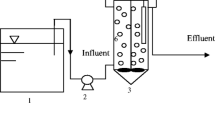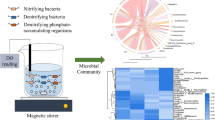Abstract
The research investigated the nitrification characteristics of two different immobilization methods: nitrifier encapsulation in polyethylene glycol (PEG) gel pellets and nitrifier biofilm attachment on elastic plastic filler. The two carriers were placed in identical reactors. They reached a maximum nitrification rate of 39 and 25 mgN/L·h 30 days after start-up. The results showed that the nitrification efficiency in the PEG reactor was higher than in the biofilm reactor under the same conditions. Variations in temperature decreased the nitrification rate by approximately 55% in the PEG reactor from 28 to 8°C, while 74.2% in the biofilm reactor. When the COD loading rate was increased to 0.8 kg/m3 day, the nitrification efficiency in the biofilm reactor dropped sharply to 23%, and that of PEG reactor remained over 80%. PEG pellets with a high nitrification rate under all conditions showed promise as an immobilization medium, and are likely to be utilized in the nitrification of high-strength ammonia and COD wastewater during long-term operation.






Similar content being viewed by others
References
Abeling U, Seyfried CF (1992) Anaerobic–aerobic treatment of high-strength ammonium wastewater nitrogen removal. Water Sci Technol 26(3):1007–1015
Anthonisen AC, Loehr RC, Prakasam TBS, Srinath EG (1976) Inhibition of nitrification by ammonia and nitrous acid. J Water Pollut Control Fed 48(5):835–852
Antonina M, Sakairi C, Yasuda K, Matsumura M (1996) Nitrogen removal in seawater using nitrifying and denitrifying bacteria immobilized in porous cellulose carrier. Water Sci Technol 34(7–8):267–274
APHA (1995) Standard methods for the examination of water and wastewater, 19th edn. American Publishers Health Association, Washington
Asano H, Myoga H, Asano M, Toyao M (1992) A study of nitrification utilizing whole micro-organisms immobilized by the PVA-freezing method. Water Sci Technol 26(3):1037–1046
Bock E, Koops HP, Harns H (1986) Cell biology of nitrifying bacteria. In: Prosser JI (ed) Nitrification. IRL Press, Oxford, pp 17–38
Brindle K, Stephenson T (1996) Nitrification in a bubbleless oxygen mass transfer membrane bioreactor. Water Sci Technol 34(9):261–267
Cao GM, Zhao QX, Sun XB, Zhang T (2002) Characterization of nitrifying and denitrifying bacteria coimmobilized in PVA and kinetics model of biological nitrogen removal by coimmobilized cells. Enzyme Microb Technol 30(1):49–55
Chen SL, Ling J, Blancheton JP (2006a) Nitrification kinetics of biofilm as affected by water quality factors. Aquac Eng 34:179–197
Chen ZQ, Wen QX, Wang JL, Li F (2006b) Simultaneous removal of carbon and nitrogen from municipal-type synthetic wastewater using net-like rotating biological contactor (NRBC). Process Biochem 41(12):2468–2472
Hashimoto N, Sumino T (1998) Wastewater treatment using activated sludge entrapped in polyethylene glycol prepolymer. J Ferment Bioeng 86(4):424–426
Isaka K, Yoshie S, Sumino T, Inamori Y, Tsuneda S (2007) Nitrification of landfill leachate using immobilized nitrifying bacteria at low temperatures. Biochem Eng J 37(1):49–55
Kamstra A, Van der Heul JW, Nijhof M (1998) Performance and optimization of trickling filters on eel farms. Aquac Eng 17:175–192
Kim SK, Kong I, Lee BH, Kang L, Lee MG, Suh KH (2000) Removal of ammonium-N from a recirculation aquacultural system using an immobilized nitrifier. Aquac Eng 21:139–150
Leenen EJTM, dos Santos VAP, Grolle KCF, Tramper J, Wijffels RH (1996) Characteristics of and selection criteria for support materials for cell immobilization in wastewater treatment. Water Res 30(12):2985–2996
Leenen EJTM, van Boxtel AMGA, Englund G, Tramper J, Wijffels RH (1997) Reduced temperature sensitivity of immobilized Nitrobacter agilis cells caused by diffusion limitation. Enzyme Microb Technol 20(8):573–580
Ling J, Chen SL (2005) Impact of organic carbon on nitrification performance of different biofilters. Aquac Eng 33:150–162
Montràs A, Pyke B, Boon N, Gòdia M, Mergeay M, Hendrickx L, Pérez J (2008) Distribution of Nitrosomonas europaea and Nitrobacter winogradskyi in an autotrophic biofilm reactor as depicted by molecular analyses and mathematical modelling. Water Res 42:1700–1714
Morita M, Kudo N, Uemoto H, Watanabe A, Shinozaki H (2007) Protective effect of immobilized ammonia oxidizers and phenol-degrading bacteria on nitrification in ammonia- and phenol containing wastewater. Eng Life Sci 7:587–592
Pruden A, Sedran M, Suidan M, Venosa A (2003) Biodegradation of MTBE and BTEX in an aerobic fluidized bed reactor. Water Sci Technol 47(9):123–128
Qiao XL, Zhang ZJ, Chen QX, Chen YJ (2008) Nitrification characteristics of PEG immobilized activated sludge at high ammonia and COD loading rates. Desalination 222:340–347
Rittmann BE, McCarty PL (2001) Environmental biotechnology: principles and applications. McGraw-Hill, New York, p 470
Rostron WM, Stuckey DC, Young AA (2001) Nitrification of high strength ammonia wastewaters: comparative study of immobilisation media. Water Res 35(5):1169–1178
Rother E, Cornel P, Ante A, Kleinert P, Brambach R (2002) Comparison of combined and separated biological aerated filter (BAF) performance for pre-denitrifcation/nitrification of municipal wastewater. Water Sci Technol 46(4–5):149–156
Tanaka K, Nakao M, Mori N, Emori H, Sumino T, Nakamura Y (1994) Application of immobilized nitrifiers gel to removal of high ammonium nitrogen. Water Sci Technol 29(9):241–250
van Ginkel CG, KChAM Luyben, Klapwijk A (1983) Characterisation of Nitrosomonas europaea immobilised in calcium alginate. Enzyme Microb Technol 5(4):297–303
Wang RC, Wen XH, Qian Y (2005) Influence of carrier concentration on the performance and microbial characteristics of a suspended carrier biofilm reactor. Process Biochem 40(9):2992–3001
Wiesman U (1994) Biological nitrogen removal from wastewater. In: Fiechter A (ed) Advances in biochemical engineering/biotechnology, vol 51. Springer, Berlin, pp 113–155
Zhu SM, Chen SL (2002) The impact of temperature on nitrification rate in fixed film biofilters. Aquac Eng 26:221–237
Acknowledgments
Thanks to Hitachi Plant Engineering and Construction Co., Ltd for supplying the PEG pellets and financial support.
Author information
Authors and Affiliations
Corresponding author
Rights and permissions
About this article
Cite this article
Li, Z., Zhang, Z., Li, J. et al. Comparative study of the nitrification characteristics of two different nitrifier immobilization methods. Biodegradation 20, 859–865 (2009). https://doi.org/10.1007/s10532-009-9273-z
Received:
Accepted:
Published:
Issue Date:
DOI: https://doi.org/10.1007/s10532-009-9273-z




